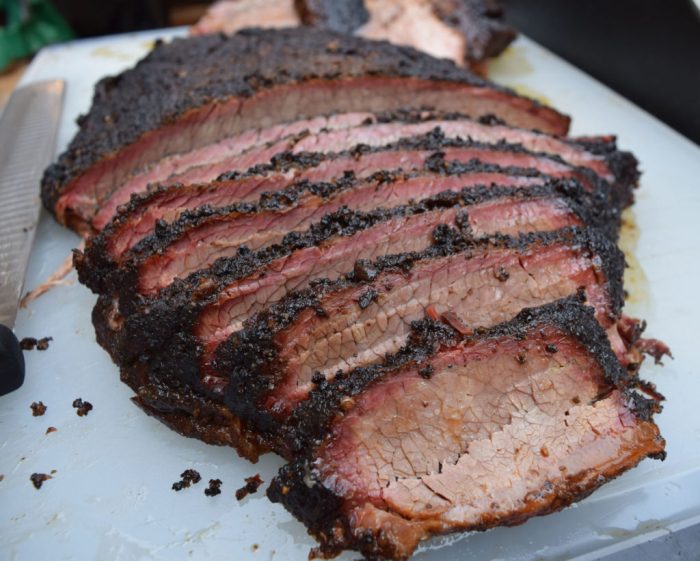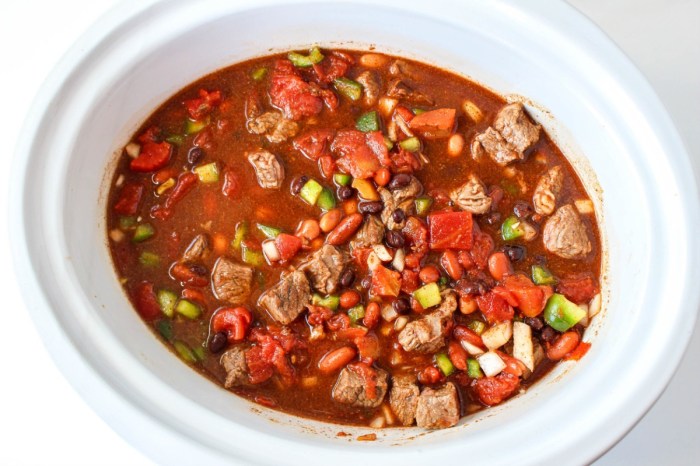Beef Brisket with Chili Sauce: A Culinary Journey
Beef brisket recipe with chili sauce – This recipe guides you through preparing a succulent beef brisket enhanced by a vibrant chili sauce. We’ll cover brisket selection, trimming, seasoning, chili sauce creation, low-and-slow cooking techniques, flavor infusion methods, serving suggestions, and troubleshooting tips.
Brisket Preparation and Selection

Source: theorioncooker.com
Choosing the right cut of brisket is crucial for achieving tender, flavorful results. A good quality, well-marbled choice or select brisket, weighing between 8-12 pounds, is ideal. The flat cut is leaner, while the point cut has more marbling and fat, leading to a more tender outcome. Many recipes utilize the whole packer brisket, which combines both cuts.
Trimming excess fat is important to prevent overly fatty results. Leave about ¼ inch of fat on the brisket’s surface for flavor and moisture. Remove any thick, hard fat deposits. This allows for even cooking and enhances the final texture.
Seasoning the brisket prior to cooking is a key step in developing its flavor. A simple dry rub consisting of salt, black pepper, garlic powder, onion powder, and paprika is a classic choice. More complex rubs can include brown sugar, chili powder, cumin, and other spices. Injecting the brisket with a flavorful marinade is another effective way to enhance its taste.
Chili Sauce Recipe Development

Source: thefoodieaffair.com
This chili sauce recipe is designed to complement the rich flavor of the brisket. It balances sweetness, heat, and acidity for a harmonious profile.
Recipe: 1 cup ketchup, ½ cup apple cider vinegar, ¼ cup brown sugar, 2 tablespoons chili powder, 1 tablespoon smoked paprika, 1 teaspoon cumin, 1 teaspoon garlic powder, ½ teaspoon onion powder, ½ teaspoon cayenne pepper (adjust to taste), salt and pepper to taste.
Variations: For a mild sauce, omit the cayenne pepper. For a medium sauce, use ½ teaspoon cayenne. For a spicy sauce, increase the cayenne pepper to 1-1.5 teaspoons. Consider adding other ingredients to further customize the flavor profile, such as chipotle peppers in adobo sauce for a smoky heat or a touch of molasses for deeper sweetness. The quality of your ingredients directly impacts the overall taste; use fresh spices and high-quality ketchup and vinegar for best results.
Cooking Methods: Low and Slow

Source: tasteofhome.com
Low-and-slow cooking methods are essential for breaking down the connective tissues in the brisket, resulting in tender, juicy meat. Smoking, braising, and slow cooking in a crockpot are popular options.
Smoking offers a smoky flavor and requires a smoker maintained at 225-250°F (107-121°C) for 12-18 hours. Braising involves searing the brisket, then simmering it in liquid in a Dutch oven or oven at 300°F (149°C) for 6-8 hours. Slow cooking in a crockpot is convenient, requiring a low setting for 8-10 hours. Precise timing depends on the size and thickness of the brisket and desired tenderness.
Step-by-step procedure (smoking): 1. Preheat smoker to 225°F (107°C). 2. Place seasoned brisket fat-side up on the smoker grate. 3.
Maintain a consistent temperature using wood chips or chunks (e.g., hickory, mesquite). 4. Monitor internal temperature using a meat thermometer. 5. Wrap the brisket in butcher paper when the internal temperature reaches 160°F (71°C) to retain moisture.
6. Continue smoking until the internal temperature reaches 200-205°F (93-96°C) for a tender brisket. 7. Rest the brisket for at least 1 hour before slicing.
Infusing Chili Sauce Flavor, Beef brisket recipe with chili sauce
The chili sauce can be incorporated at various stages to achieve different flavor profiles. Basting the brisket with the sauce during the last few hours of cooking adds a sweet and spicy glaze. Adding the sauce during the resting period allows the brisket to absorb the flavor without risking burning. Glazing with the chili sauce in the final 30 minutes enhances the visual appeal and intensifies the flavor.
Adding the chili sauce too early may cause it to burn or become overly thick. The timing of addition affects the final flavor profile, with later addition leading to a more pronounced glaze and earlier addition resulting in a more infused flavor throughout the meat. To prevent burning, use a lower heat setting during the last stages of cooking when adding the sauce.
Reduce the sauce on the stovetop if it becomes too thick.
Serving Suggestions and Presentation
The ideal texture for a finished beef brisket is tender and juicy, easily sliced or shredded. The internal temperature should reach 200-205°F (93-96°C).
| Serving Style | Description |
|---|---|
| Sliced Brisket | Thinly sliced against the grain, showcasing the beautiful pink and brown layers. Serve with the chili sauce on the side for dipping. |
| Shredded Brisket | Pulled apart and mixed with the chili sauce, creating a flavorful, easy-to-eat dish. |
| Brisket Tacos | Shredded brisket with chili sauce, served in warm tortillas with your favorite toppings. |
| Brisket Sandwiches | Shredded brisket with chili sauce on a toasted bun, optionally adding coleslaw or pickles. |
Imagine the glistening, mahogany-colored brisket, its surface glazed with a rich, dark chili sauce. The aroma of smoked meat and sweet chili fills the air. The tender meat, easily sliced or shredded, melts in your mouth, with the chili sauce adding a burst of sweet and spicy flavor that perfectly complements the smoky richness of the beef.
Troubleshooting and Tips
Common problems include dry brisket and uneven cooking. Dry brisket can be avoided by using a meat thermometer and wrapping the brisket in butcher paper during the later stages of cooking. Uneven cooking can be prevented by ensuring even heat distribution in the smoker or oven.
Achieving tender, juicy brisket requires careful attention to temperature and cooking time. Using a meat thermometer is essential for ensuring the brisket reaches the proper internal temperature. Different cuts may require slight adjustments to cooking time. Allowing the brisket to rest after cooking helps retain moisture and tenderness.
- Q: How do I know when my brisket is done? A: Use a meat thermometer; it should reach an internal temperature of 200-205°F (93-96°C).
- Q: What if my chili sauce is too thick? A: Add a little water or vinegar to thin it out.
- Q: Can I use a different type of chili powder? A: Yes, experiment with different chili powders to customize the heat and flavor.
FAQ Insights: Beef Brisket Recipe With Chili Sauce
Can I use a pre-made chili sauce?
While a homemade chili sauce offers the best flavor control and customization, you can certainly use a high-quality store-bought chili sauce. Adjust the amount used based on the sauce’s spice level and desired intensity.
How do I know when the brisket is done?
The brisket should be fork-tender, easily shredding with minimal effort. An internal temperature of 195-205°F (90-96°C) is a good indicator of doneness.
What if my chili sauce burns?
Reduce the heat and add a tablespoon or two of water or broth to help prevent burning. Stir frequently to ensure even cooking and prevent sticking.
Can I make the chili sauce ahead of time?
Yes, the chili sauce can be made up to 3 days in advance and stored in an airtight container in the refrigerator.
